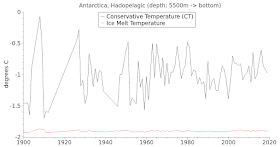 |
| Fig. 1 Pelagic Depths |
I. Begin Here
In the previous post of this series I focused on the news about the first ever measurements of seawater temperature at the grounding line of the Thwaites Glacier.
That is an incredible bit of news for several reasons, such as since Thwaites is nicknamed 'The Doomsday Glacier' why has it taken so long to get to the bottom of it?
Or, why do we know more about the surface of Mars and the Moon than we know about the bottom of the Earth's oceans?
 |
| Fig. 2 Epipelagic Depth |
 |
| Fig. 3 Mesopelagic Depth |
 |
| Fig. 4 Bathypelagic Depth |
 |
| Fig. 5 Abyssopelagic Depth |
 |
| Fig. 6 Hadopelagic Depth |
 |
| Fig. 7 All Pelagic Depths |
Remember this reality (You Are Here) and:
"A team of scientists has observed, for the first time, the presence of warm water at a vital point underneath a glacier in Antarctica--an alarming discovery that points to the cause behind the gradual melting of this ice shelf while also raising concerns about sea-level rise around the globe.(Antarctica 2.0 - 8, emphasis added). The two degrees Celsius above the abstract freezing temperature of zero C is significant as will be shown.
Warm waters in this part of the world, as remote as they may seem, should serve as a warning to all of us about the potential dire changes to the planet brought about by climate change," explains David Holland, director of New York University's Environmental Fluid Dynamics Laboratory and NYU Abu Dhabi's Center for Global Sea Level Change, which conducted the research. "If these waters are causing glacier melt in Antarctica, resulting changes in sea level would be felt in more inhabited parts of the world.
The recorded warm waters--more than two degrees above freezing--flow beneath the Thwaites Glacier, which is part of the Western Antarctic Ice Sheet. The discovery was made at the glacier's grounding zone--the place at which the ice transitions between resting fully on bedrock and floating on the ocean as an ice shelf and which is key to the overall rate of retreat of a glacier."
II. About The Graphs
Today's graphs are mean averages of in situ measurements of seawater temperatures in the World Ocean Database (WOD) Zones that encircle Antarctica.
They are presented at the five pelagic depths rather than the thirty-three WOD depths so they fit more easily on one blog page.
Additionally, in some of the zones around Antarctica there are few measurements, which makes the graphs cranky, so averaging them into the pelagic depths smooths them out a bit.
III. The Main Purpose of These Graphs
The main purpose of these graphs today is to contrast the freeze/thaw temperatures of seawater according to the modern TEOS formulas in the TEOS toolbox.
The graphs show the seawater temperature measurements over the past hundred years or so.
Below those temperature graph lines the melt temperature of seawater under those seawater conditions (temperature, salinity, depth) is shown.
The bottom line is that the water around Antarctica will melt tidewater glacier ice when it comes in contact with it.
But more than that, the scientists who checked out the grounding line at Thwaites glacier measured the seawater temperature to be two degrees Celsius (2 deg. C).
That is warmer than the in situ measurements in the WOD database up to last year (2019) as the graphs show.
IV. Closing Comments
In the next post of this series I will show graphs of the sections of Antarctica in terms of how much grounding line (where tidewater glaciers leave the land and begin to float) each one has.
The next post in this series is here, the previous post in this series is here.
"Climate Models Are Running Red Hot, and Scientists Don't Know Why" (link)
ReplyDeleteAre they using the same software that the Iowa Caucus is?